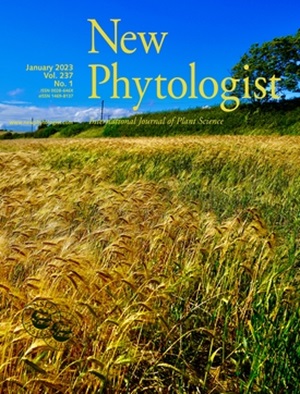Formation and centromere inactivation of fusion chromosomes in two allotetraploid species from the Saccharum complex.
IF 8.1
1区 生物学
Q1 PLANT SCIENCES
引用次数: 0
Abstract
Chromosome fusion can cause a change in the basic chromosome number of a species, thus imposing a major impact on speciation. However, there are few studies on the structure and evolution of fusion chromosomes in plants. Erianthus rockii and Narenga porphyrocoma are allotetraploid species within the Saccharum complex. Both species possess five distinct fusion chromosomes, each resulting from the fusion of two ancestral chromosomes. We developed a high-resolution oligonucleotide (oligo)-based painting technique and constructed a detailed cytogenetic map for each of the 10 fusion chromosomes, enabling visualization of the breakpoints and fusion events of their ancestral chromosomes. We observed several common features associated with the 10 fusion chromosomes. The breakpoints of these fusion chromosomes were consistently located in the proximal regions near the centromeres of the ancestral chromosomes. Each fusion event was accompanied by the inactivation of one of the two ancestral centromeres, along with the loss of the associated centromeric repeats in the inactivated centromere. We conclude that the 10 fusion chromosomes likely originated through different mechanisms, including nested chromosome fusion, end-to-end fusion, and centromere misdivision followed by rejoining of the resulting fragments.Saccharum复合体中两个异源四倍体物种融合染色体的形成和着丝粒失活。
染色体融合可以引起物种基本染色体数目的变化,从而对物种形成产生重大影响。然而,对植物融合染色体的结构和进化研究较少。石竹和斑马花是Saccharum复合体内的异源四倍体物种。这两个物种都有五条不同的融合染色体,每一条都是由两条祖先染色体融合而成的。我们开发了一种高分辨率的基于寡核苷酸(oligo)的绘画技术,并为10条融合染色体中的每一条构建了详细的细胞遗传学图谱,使其祖先染色体的断点和融合事件可视化。我们观察到与10条融合染色体相关的几个共同特征。这些融合染色体的断点始终位于祖先染色体的着丝粒附近的近端区域。每次融合事件都伴随着两个祖先着丝粒中的一个失活,以及失活的着丝粒中相关的着丝粒重复序列的丢失。我们得出结论,这10条融合染色体可能起源于不同的机制,包括嵌套染色体融合、端到端融合和着丝粒错误分裂,然后将产生的片段重新连接。
本文章由计算机程序翻译,如有差异,请以英文原文为准。
求助全文
约1分钟内获得全文
求助全文
来源期刊

New Phytologist
生物-植物科学
自引率
5.30%
发文量
728
期刊介绍:
New Phytologist is an international electronic journal published 24 times a year. It is owned by the New Phytologist Foundation, a non-profit-making charitable organization dedicated to promoting plant science. The journal publishes excellent, novel, rigorous, and timely research and scholarship in plant science and its applications. The articles cover topics in five sections: Physiology & Development, Environment, Interaction, Evolution, and Transformative Plant Biotechnology. These sections encompass intracellular processes, global environmental change, and encourage cross-disciplinary approaches. The journal recognizes the use of techniques from molecular and cell biology, functional genomics, modeling, and system-based approaches in plant science. Abstracting and Indexing Information for New Phytologist includes Academic Search, AgBiotech News & Information, Agroforestry Abstracts, Biochemistry & Biophysics Citation Index, Botanical Pesticides, CAB Abstracts®, Environment Index, Global Health, and Plant Breeding Abstracts, and others.
 求助内容:
求助内容: 应助结果提醒方式:
应助结果提醒方式:


